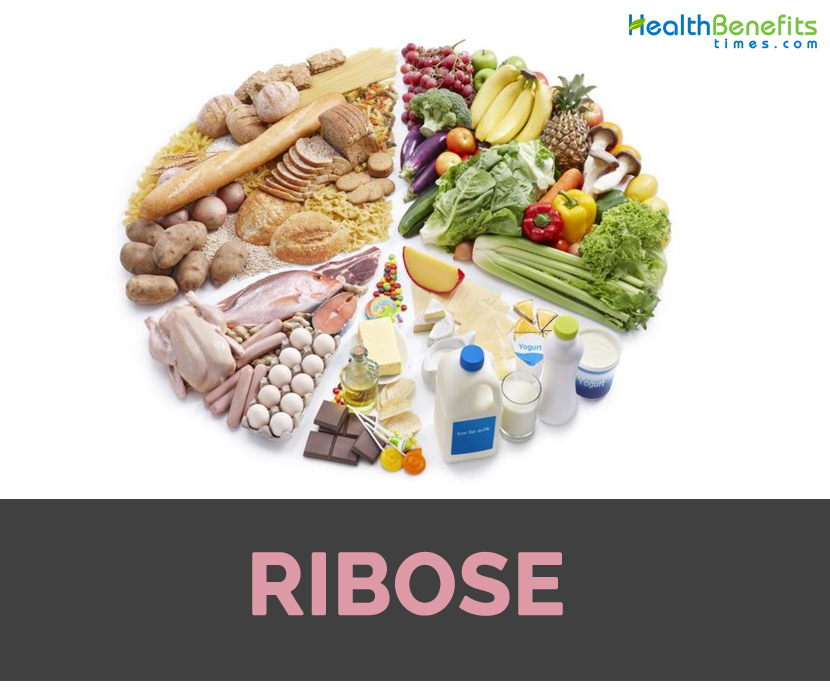 Ribose is a pentose sugar which is present in all living cells. It is crucial to maintain healthy total adenine nucleotide pools and eventually for formation of adenosine triphosphate and promotes skeletal or cardiac muscle energy metabolism. It is a carbohydrate having C5H10O5 formula. It is a pentose monosaccharide having linear form H−(C=O)−(CHOH)4−H with all hydroxyl groups on same side in Fischer projection.
Ribose is a pentose sugar which is present in all living cells. It is crucial to maintain healthy total adenine nucleotide pools and eventually for formation of adenosine triphosphate and promotes skeletal or cardiac muscle energy metabolism. It is a carbohydrate having C5H10O5 formula. It is a pentose monosaccharide having linear form H−(C=O)−(CHOH)4−H with all hydroxyl groups on same side in Fischer projection.
The term ribose refers to two enantiomers. Usually the term indicates D-ribose that occurs widely in nature. L-ribose is not found in nature. In 1891, D-ribose was reported by Emil Fischer. Ribose is a five-carbon sugar that is critical to the production of ATP. Ribose supplementation is claimed to improve athletic performance by increasing work output and promoting a faster recovery time from vigorous training. While ribose has been shown to improve exercise tolerance in patients with heart disease, several studies have reported that ribose supplementation has no impact on athletic performance.
Food Sources of Ribose
- Chicken
- Ground Beef
- Salmon
- Almonds
- Milk
- Eggs
- Cheddar cheese
- Spinach
- Asparagus
- Broccoli
- White bread
- Whole wheat bread
Health Benefits of Ribose
Listed below are the health benefits of Ribose:
- Heart health
A key study published in 2003 showed that D-ribose improved both diastolic function and quality of life in patients with congestive heart failure. This study included 15 patients with coronary heart disease and congestive heart failure. It was a double-blind, randomized trial with crossover, so that both groups eventually received the D-ribose. Improvements in heart function were seen on echocardiography, a test with sound waves like a sonogram. In this study, 5 g of D-ribose was given three times a day and there were no adverse effects.
While it seems clear that D-ribose can improve ATP stores that may be depleted in ischemic myocardium, it is not equally clear how much actual improvement is made in the cardiac muscle. In one study, investigators stressed myocardium with a drug called dobutamine, to see if D-ribose would improve the contraction of healthy myocardium when given dobutamine. They also looked at whether or not intravenous D-ribose could reduce ischemia of the cardiac muscle under the dobutamine stress.
- Energy and Endurance
In a rat model of cardiomyopathy, D-ribose improves the heart muscle’s ability to work. D-ribose can also help living heart muscle work better after the recent death of adjacent heart muscle.
From a variety of animal and human tests, D-ribose shows promise in limiting damage and aiding recovery of heart muscle that has had a lack of oxygen supply.
A key study published in 2003 showed that D-ribose improved both diastolic function and quality of life in patients with congestive heart failure. This study included 15 patients with coronary heart disease and congestive heart failure. It was a double-blind, randomized trial with crossover, so that both groups eventually received the D-ribose. Improvements in heart function were seen on echocardiography, a test with sound waves like a sonogram. In this study, 5 g of D-ribose was given three times a day and there were no adverse effects.
- Treat Chronic Fatigue Syndrome
The first was a case study of an individual patient in 2004, who suffered from fibromyalgia. D-ribose was added to her treatment with a decrease in her symptoms. It was postulated that the extra ATP that might be made could help increase her energy reserves and lessen symptoms.
There has also been one open-label, uncontrolled pilot study of D-ribose in treating both fibromyalgia (FMS) and chronic fatigue syndrome (CFS). Both conditions may be associated with decreased energy metabolism at a cellular level. Forty-one patients were given D-ribose. The dose was 5 g, three times a day until a total of 280 g was taken.
- Skin
ATP levels decline in aging skin. The levels drop in fibroblasts, which are important to maintain youthful tone. It has been postulated that the decline in ATP may contribute to the appearance of aging. In culture, skin fibroblasts regenerate ATP and have increased rate of energy production when given D-ribose. In a clinical study, 20 adult women used a facial lotion with 0.5 percent D-ribose. There was a reduction in the appearance of wrinkles at 14 days and further reduction at 28 days. This was said to be evaluated both subjectively, by the women using the lotion, and objectively by the investigators.
- Kidney function
D-ribose lower kidney dysfunction and tissue damage caused by chemotherapy drug Cisplatin in mice. It lowers kidney damage caused due to insufficient supply of blood and inadequate neutrophil activation in rats.
- Brain activity
D-ribose prevents the activation of pro-apoptotic genes in the hippocampus which demonstrated a neuroprotective effect in mice having irregular heartbeat. The deficiency of adenylosuccinate lyase causes psychomotor deficiency, autistic and seizures. In 13 year old female, motor coordination or seizure symptoms were controlled by assorted months of D-ribose therapy.
Precautions
Pregnant or lactating women should consult physician before using this product. People might experience diarrhea, nausea, gastrointestinal discomfort and headache.
References:
https://en.wikipedia.org/wiki/Ribose
http://www.newworldencyclopedia.org/entry/Ribose
https://www.pureencapsulations.com/media/Ribose.pdf
https://www.selfhacked.com/blog/d-ribose-health-benefits/
